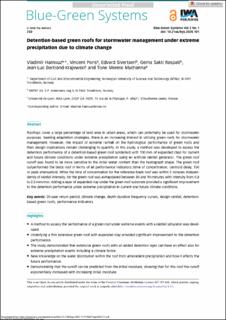| dc.contributor.author | Hamouz, Vladimir | |
| dc.contributor.author | Pons, Vincent | |
| dc.contributor.author | Sivertsen, Edvard | |
| dc.contributor.author | Raspati, Gema Sakti | |
| dc.contributor.author | Bertrand-Krajewski, Jean-Luc | |
| dc.contributor.author | Muthanna, Tone Merete | |
| dc.date.accessioned | 2020-08-19T10:47:15Z | |
| dc.date.available | 2020-08-19T10:47:15Z | |
| dc.date.created | 2020-08-14T14:29:14Z | |
| dc.date.issued | 2020 | |
| dc.identifier.uri | https://hdl.handle.net/11250/2672967 | |
| dc.description.abstract | Rooftops cover a large percentage of land area in urban areas, which can potentially be used for stormwater
purposes. Seeking adaptation strategies, there is an increasing interest in utilising green roofs for stormwater
management. However, the impact of extreme rainfall on the hydrological performance of green roofs and
their design implications remain challenging to quantify. In this study, a method was developed to assess the
detention performance of a detention-based green roof (underlaid with 100 mm of expanded clay) for current
and future climate conditions under extreme precipitation using an artificial rainfall generator. The green roof
runoff was found to be more sensitive to the initial water content than the hyetograph shape. The green roof
outperformed the black roof in terms of all performance indicators (time of concentration, centroid delay, T50
or peak attenuation). While the time of concentration for the reference black roof was within 5 minutes independently of rainfall intensity, for the green roof was extrapolated between 30 and 90 minutes with intensity from 0.8
to 2.5 mm/min. Adding a layer of expanded clay under the green roof substrate provided a significant improvement
to the detention performance under extreme precipitation in current and future climate conditions. | en_US |
| dc.language.iso | eng | en_US |
| dc.publisher | IWA Publishing | en_US |
| dc.rights | Navngivelse 4.0 Internasjonal | * |
| dc.rights.uri | http://creativecommons.org/licenses/by/4.0/deed.no | * |
| dc.title | Detention-based green roofs for stormwater management under extreme precipitation due to climate change | en_US |
| dc.type | Peer reviewed | en_US |
| dc.type | Journal article | en_US |
| dc.description.version | publishedVersion | en_US |
| dc.source.volume | 2 | en_US |
| dc.source.journal | Blue-Green Systems | en_US |
| dc.source.issue | 1 | en_US |
| dc.identifier.doi | 10.2166/bgs.2020.101 | |
| dc.identifier.cristin | 1823389 | |
| dc.relation.project | Norges forskningsråd: 237859 | en_US |
| dc.description.localcode | © 2020 The Authors This is an Open Access article distributed under the terms of the Creative Commons Attribution Licence (CC BY 4.0), which permits copying, adaptation and redistribution, provided the original work is properly cited (http://creativecommons.org/licenses/by/4.0/). | en_US |
| cristin.ispublished | true | |
| cristin.fulltext | original | |
| cristin.qualitycode | 1 | |

